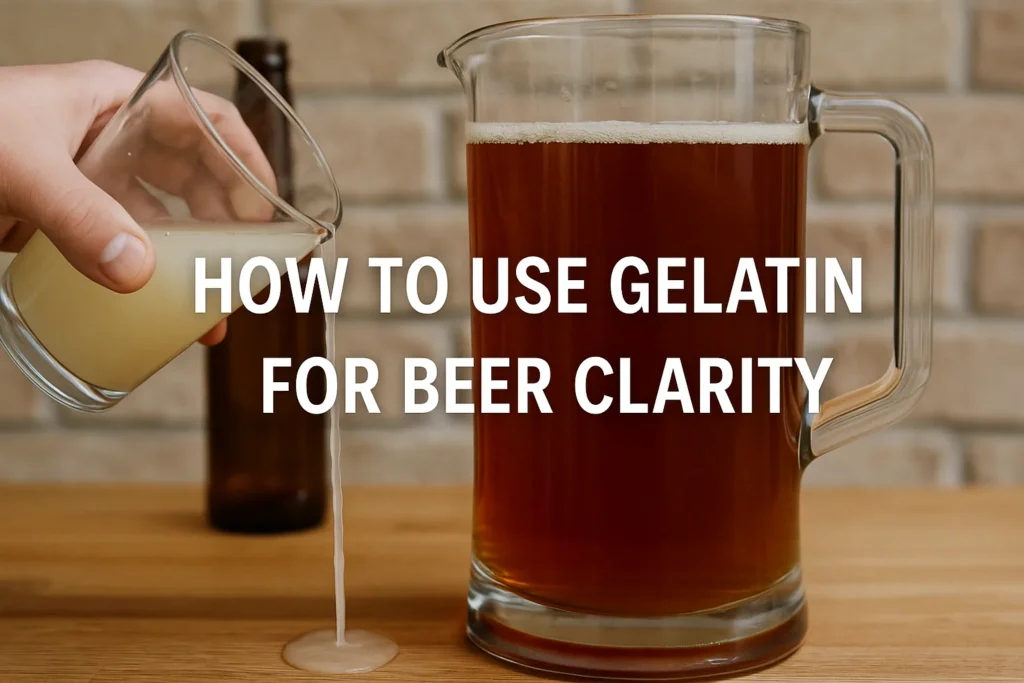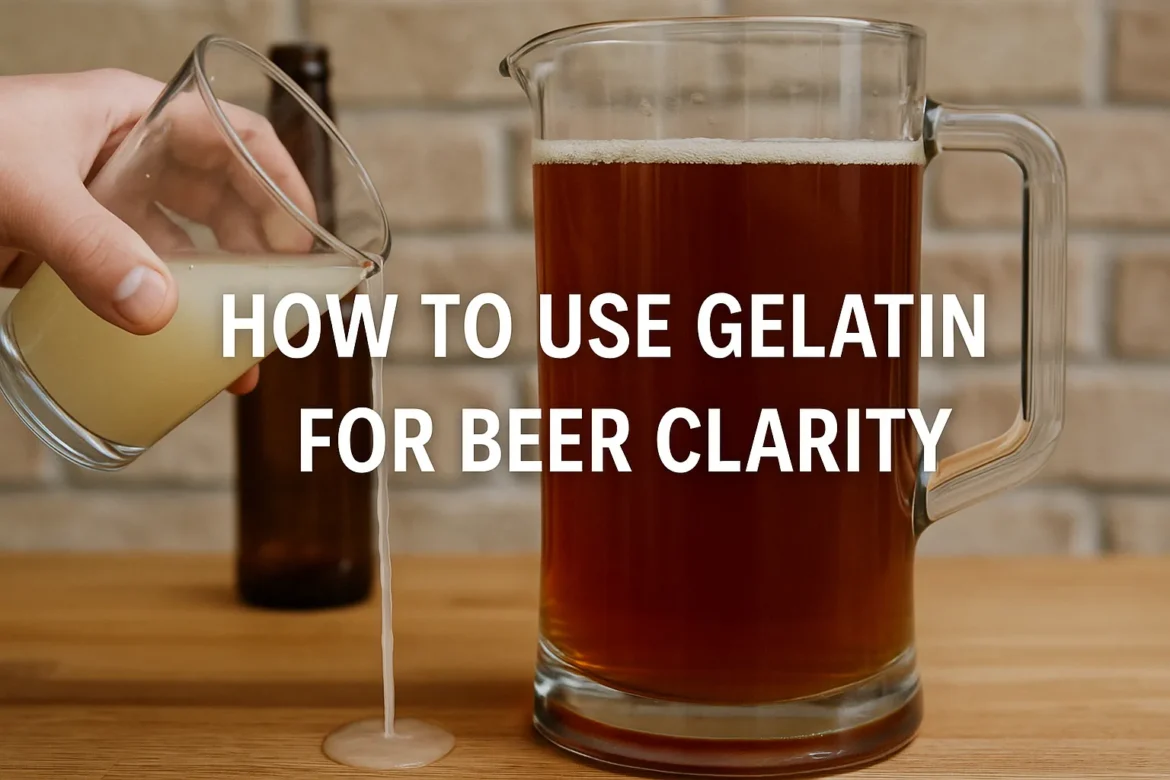Learn how to use gelatin for beer clarity with our step-by-step guide. Discover proper dosing, timing, and techniques to achieve crystal-clear homebrew without affecting flavor or aroma.
Have you ever held up your homemade beer to the light, only to wince at its cloudy appearance? You’ve crafted the perfect recipe, nailed your fermentation temperatures, and the taste is incredible—yet something’s missing. That crystal-clear brilliance that makes a great beer not just taste professional, but look professional too.

Enter gelatin fining—perhaps the most effective, affordable, and accessible method to achieve commercial-quality clarity in your homebrew. As a longtime brewer who’s experimented with every clearing agent under the sun, I can confidently say that gelatin offers the best balance of effectiveness, ease of use, and minimal impact on your beer’s flavor profile.
In this comprehensive guide, I’ll walk you through everything you need to know about using gelatin to transform your cloudy concoction into a brilliantly clear beverage that would make any commercial brewer proud.
What Causes Cloudy Beer?
Before diving into how gelatin works, it’s important to understand what causes haze in beer in the first place. Cloudiness in beer typically comes from:
- Protein-polyphenol complexes: Proteins from malt interact with polyphenols (tannins) from malt and hops, forming complexes that remain suspended in your beer.
- Yeast suspension: Even after fermentation is complete, yeast cells can remain suspended in your beer, creating a hazy appearance.
- Chill haze: Proteins that are soluble at room temperature but become insoluble and visible when beer is chilled.
- Starch haze: Unconverted starches from poor mashing techniques.
- Bacterial infection: While less common, bacterial contamination can also cause cloudiness (along with off-flavors).
According to the American Society of Brewing Chemists, protein-polyphenol complexes and suspended yeast are the most common culprits in homebrewed beer, and fortunately, these are precisely what gelatin targets.
How Gelatin Works as a Fining Agent
Gelatin is a protein-based fining agent derived from collagen, typically from animal sources like cow or pig. When added to beer, it works through a process called flocculation—essentially helping particles stick together and settle out of suspension.
Here’s the science behind it:
Gelatin carries a positive electrical charge (it’s cationic). Many of the substances causing haze in your beer—particularly yeast cells and protein-polyphenol complexes—carry a negative charge. When introduced to your beer, gelatin attracts these oppositely charged particles, forming larger clumps that become heavy enough to drop to the bottom of your fermenter.
What makes gelatin particularly effective is its specificity. Research published in the Journal of the Institute of Brewing has shown that gelatin primarily binds to the problematic compounds causing haze while leaving desirable flavor and aroma compounds largely untouched.
Types of Gelatin for Beer Clarification
Not all gelatin is created equal when it comes to beer fining. Here are your options:
| Type | Description | Pros | Cons | Recommended For |
|---|---|---|---|---|
| Unflavored Culinary Gelatin | Standard grocery store gelatin (Knox, etc.) | Readily available, inexpensive | Variable quality, may contain additives | Beginners, emergency clarity situations |
| Brewing-Specific Gelatin | Gelatin formulated specifically for brewing | Consistent quality, free of additives | More expensive, must be ordered | Regular brewers seeking consistent results |
| Sheet Gelatin (Professional) | Used in professional brewing and cooking | Precisely measured strength (bloom), consistent | Harder to find, more complex to use | Advanced brewers, competition beers |
| Vegan Alternatives | Non-animal derived alternatives like Biofine Clear | Vegan-friendly | More expensive, slightly different technique | Brewers avoiding animal products |
For most homebrewers, unflavored culinary gelatin (like Knox) works perfectly well. If you’re brewing frequently or entering competitions, brewing-specific gelatin may be worth the investment for consistent results.
Necessary Equipment and Ingredients
The beauty of gelatin fining is that it requires minimal specialized equipment. Here’s what you’ll need:
Equipment:
- Small saucepan or microwave-safe container
- Thermometer (digital preferred for accuracy)
- Sanitized spoon or whisk for stirring
- Sanitized container for mixing
- Syringe or sanitized measuring cup for adding to beer
Ingredients:
- Unflavored gelatin powder (1/2 to 1 teaspoon per 5 gallons of beer)
- Cold, filtered water (1/4 to 1/2 cup)
- Your beer (already fermented and ready for packaging)
Step-by-Step Guide to Using Gelatin for Beer Clarity
Now for the practical application. Follow these steps for optimal results:
1. Timing Is Everything
The best time to add gelatin is:
- After primary fermentation is complete (stable gravity readings for 2-3 days)
- When your beer has been cold crashed (if possible)
- 1-3 days before you plan to package
Adding gelatin too early can strip away desirable compounds and yeast that may still be active. Adding it too late won’t give particles enough time to settle out.
2. Prepare Your Gelatin Solution
🍺 Pro-Tip: Cold crash your beer before adding gelatin! Dropping your beer's temperature to near-freezing (33-38°F/0-3°C) for 24-48 hours before adding gelatin will dramatically improve clarity results.
- Measure gelatin powder: Use 1/2 to 1 teaspoon (2-4 grams) of gelatin powder per 5 gallons (19 liters) of beer. For lighter styles like pilsners or blonde ales, lean toward the higher amount. For darker beers where perfect clarity is less critical, the lower amount should suffice.
- Bloom the gelatin: Add the gelatin powder to 1/4 cup (60ml) of cold water in your sanitized container. Let it stand for 5-10 minutes to hydrate (or “bloom”).
- Heat gently: Heat the bloomed gelatin mixture to 150-155°F (65-68°C). This can be done:
- On the stovetop using a small saucepan
- In a microwave in short 5-10 second bursts, stirring between each
- In a water bath for more precise temperature control
CAUTION: Do not exceed 160°F (71°C) as this can degrade the gelatin’s effectiveness. Use your thermometer to verify the temperature.
- Hold temperature briefly: Maintain this temperature for about 10-15 minutes to ensure the gelatin fully dissolves and any potential contaminants are pasteurized.
- Cool slightly: Allow the mixture to cool to just above your beer temperature before adding. If your beer is cold crashed, you may need to cool the gelatin to around 70-80°F (21-27°C) to prevent thermal shock.
3. Add Gelatin to Your Beer
Once your gelatin solution is prepared, it’s time to add it to your beer:
- Sanitize everything: Ensure the utensils and containers you’re using are properly sanitized.
- Add gradually: Add the gelatin solution to your beer gently to prevent oxidation. Methods include:
- If using a carboy: Slowly pour down the side of the vessel
- If using a conical fermenter: Add through the top port
- If using a keg: Add to the keg before transferring beer, or inject through a liquid-out disconnect
- Mix gently: A gentle swirl or rock of your fermenter will help distribute the gelatin without introducing oxygen.
4. Cold Condition
After adding gelatin, temperature plays a crucial role:
- Keep it cold: Maintain cold temperatures (33-40°F/0-4°C) for 48-72 hours. The colder the beer, the more effectively gelatin works.
- Be patient: While you might see dramatic clearing within 24 hours, optimal clarity typically takes 2-3 days.
5. Package Carefully
When packaging gelatin-fined beer:
- Avoid the bottom inch: Leave behind the sediment at the bottom of your fermenter when transferring to bottles or kegs.
- Consider a closed transfer: To prevent disturbing the settled particles, a closed pressure transfer is ideal.
- For bottling: If you’re bottle conditioning, add slightly more priming sugar than usual (around 5-10% extra) as gelatin may have dropped out some of the yeast needed for carbonation.
Gelatin Fining for Different Beer Styles
The approach to gelatin fining varies slightly depending on beer style:
Pale Lagers and Pilsners
These styles benefit most from gelatin fining, as clarity is a defining characteristic. Use the full dose of gelatin after a 3-5 day cold crash for brilliant results.
Pale Ales and IPAs
Modern IPAs often embrace haze, particularly New England IPAs where haziness is desirable. For West Coast styles where clarity is preferred, use gelatin but be aware it may slightly reduce hop aroma intensity. Consider dry hopping after gelatin has cleared the beer if aroma is a priority.
I’ve detailed advanced hopping techniques for various IPA styles in our comprehensive guide to brewing perfect IPAs on our main site.
Belgian Styles
Traditional Belgian beers often have a slight haze that’s considered appropriate. If using gelatin, a reduced dose (1/4 to 1/3 teaspoon per 5 gallons) is recommended to maintain some traditional character.
Wheat Beers and Hefeweizens
These styles traditionally showcase haziness as part of their character. Gelatin fining is generally not recommended as it works against the style guidelines.
Stouts and Porters
Dark beers mask haze naturally, so gelatin is less critical. However, it can still improve mouthfeel and reduce astringency by removing excess polyphenols. Use a standard dose if desired.
Common Problems and Troubleshooting
Even with a seemingly simple process like gelatin fining, issues can arise. Here are solutions to common problems:
Beer Still Cloudy After Gelatin
If your beer remains cloudy after gelatin treatment:
- Check temperature: Your beer may not be cold enough. Gelatin works optimally below 40°F (4°C).
- Allow more time: Some beers, especially highly hopped ones, may need up to 5-7 days to fully clear.
- Consider multiple issues: If starch haze or bacterial infection is present, gelatin won’t fix these problems.
- Try additional fining: For stubborn haze, a combination approach using both gelatin and a silica-based fining agent like Kieselsol can be effective.
Off-Flavors After Using Gelatin
If you detect new off-flavors after using gelatin:
- Check for contamination: The gelatin preparation process may have introduced bacteria.
- Review temperature control: Heating gelatin too high can create unpleasant flavors that transfer to beer.
- Consider oxidation: The process of adding gelatin may have introduced oxygen. Next time, minimize splashing and consider a closed transfer method.
Poor Head Retention
Occasionally, excessive use of gelatin can impact head retention:
- Reduce dosage: Try using the lower end of the recommended gelatin amount.
- Adjust timing: Add gelatin later in the conditioning process.
- Balance with protein-positive additions: Consider adding a small amount of carapils or wheat malt to your next batch to improve foam-positive proteins.
According to a study by Oregon State University’s Fermentation Science program, moderate gelatin use (0.5-1 tsp per 5 gallons) rarely causes significant head retention issues in properly formulated recipes.
The Environmental and Ethical Considerations
As many brewers become more environmentally and ethically conscious, it’s worth addressing some considerations around gelatin use:
Animal-Based Product
Gelatin is derived from animal collagen, typically from cows or pigs. For vegetarian or vegan brewers, alternative fining agents include:
- Biofine Clear (silicic acid)
- Irish moss or carrageenan (seaweed-derived)
- Silica gel (synthetic)
These alternatives may require slightly different techniques, but many commercial craft breweries have successfully switched to plant-based finings.
Sustainability
From a sustainability perspective, gelatin represents a use of animal byproducts that might otherwise go to waste. However, for brewers concerned about the environmental impact of animal agriculture, plant-based alternatives may align better with their values.
Beyond Gelatin: Other Clarity Approaches
While gelatin is extremely effective, it’s not the only approach to beer clarity:
Prevention Over Treatment
The best clarity often comes from good brewing practices upstream:
- Proper mash pH and temperature: A well-controlled mash between 148-158°F (64-70°C) with pH 5.2-5.6 reduces protein haze.
- Extended boil: A vigorous 90-minute boil can break down proteins that cause haze.
- Thorough wort cooling: Rapidly cooling wort after boiling helps proteins drop out before fermentation.
- Yeast selection: High-flocculating yeast strains naturally produce clearer beer.
Alternative Fining Agents
Each fining agent works differently and targets specific compounds:
| Fining Agent | Source | What It Targets | Best For |
|---|---|---|---|
| Irish Moss | Seaweed | Hot-side proteins | Adding during boil |
| Whirlfloc | Modified seaweed | Hot-side proteins | Adding during boil |
| Isinglass | Fish bladders | Yeast cells | Post-fermentation |
| PVPP (Polyclar) | Synthetic | Polyphenols | Chill haze prevention |
| Silica gel | Synthetic | Proteins | Works well with gelatin |
Time and Cold
Sometimes the best clarifier is simply patience:
- Extended cold conditioning: Given enough time (3-4 weeks) at cold temperatures (33-38°F/0-3°C), many beers will clear naturally.
- Lagering: Traditional lagering involves holding beer near freezing for weeks or months, resulting in exceptional clarity without finings.
Gelatin Use in Commercial Brewing
While this guide focuses on homebrewing applications, it’s worth noting how commercial breweries approach clarification:
Most craft breweries use a combination of techniques, with many relying on centrifuges or filtration rather than fining agents. However, according to the Brewers Association, approximately 30% of craft breweries still use some form of fining agent, with gelatin remaining popular due to its cost-effectiveness and minimal impact on flavor.
Larger commercial breweries often use automated dosing systems for precision application of fining agents, followed by filtration processes that would be impractical for homebrewers.
Frequently Asked Questions About Gelatin Fining
Over my years of teaching homebrewing workshops, these are the questions that come up most frequently:
Q: Will gelatin strip flavors from my beer? A: When used correctly, gelatin primarily binds to haze-causing compounds and yeast, with minimal impact on flavor compounds. Some subtle hop aroma may be reduced, but the effect is generally negligible.
Q: Is beer fined with gelatin vegetarian/vegan? A: No. Beer fined with gelatin contains animal products and is not suitable for vegetarians or vegans. Consider alternative fining agents if this is a concern.
Q: Can I use flavored gelatin if that’s all I have? A: Absolutely not. Flavored gelatin contains sugars, artificial flavors, and colors that will drastically alter your beer. Only use unflavored gelatin.
Q: Will gelatin affect bottle conditioning? A: It can reduce yeast counts, potentially slowing carbonation. For bottle-conditioned beers, either add slightly more priming sugar or add fresh yeast at bottling time.
Q: How much does temperature matter? A: Temperature is critical in two ways: the heating of gelatin solution (to dissolve but not denature it) and the temperature of your beer (colder beer clarifies more effectively with gelatin).
Q: Can I add gelatin directly to bottles to clear already-packaged beer? A: This is not recommended, as it would create sediment in the bottles without a good way to separate it from the beer.
The Clear Path Forward
Achieving professional-level clarity in your homebrewed beer doesn’t require expensive equipment or commercial-scale processes. A simple, well-executed gelatin fining can transform your beer’s appearance while preserving the flavors and aromas you’ve worked so hard to create.
Remember these key points:
- Timing matters: Add gelatin after fermentation is complete and beer is cold.
- Temperature control is crucial: Both when preparing gelatin and when conditioning your beer.
- Less is often more: Start with conservative amounts of gelatin and adjust based on results.
- Style appropriateness: Consider whether clarity is even desirable for your chosen beer style.
By understanding how gelatin works and following proper technique, you’ll be able to produce homebrew that not only tastes like commercial craft beer but looks the part too—crystal clear and professional in appearance.
Whether you’re preparing for a competition, trying to impress friends, or simply satisfying your own brewing standards, mastering gelatin fining is a valuable skill in any homebrewer’s toolkit.
About the Author:
Mark Kegman is a product tester and review expert who spent 15 years as a mechanical engineer before turning his analytical mind to brewing equipment. His methodical approach to testing and reviewing brewing gear has earned him a reputation for thorough, unbiased assessments. Mark maintains a fully equipped home brewery lab where he puts everything from budget starter kits to professional-grade systems through rigorous testing protocols. He’s particularly passionate about helping brewers find the best value equipment and innovative solutions for small-space brewing setups. His detailed comparison videos have amassed over 2 million views online.

